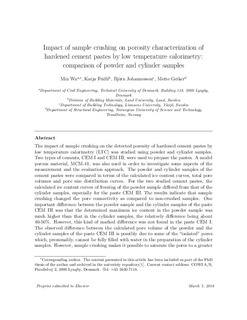| dc.contributor.author | Wu, Min | |
| dc.contributor.author | Fridh, Katja | |
| dc.contributor.author | Johannesson, Björn | |
| dc.contributor.author | Geiker, Mette Rica | |
| dc.date.accessioned | 2019-02-05T10:20:43Z | |
| dc.date.available | 2019-02-05T10:20:43Z | |
| dc.date.created | 2018-05-16T07:29:31Z | |
| dc.date.issued | 2018 | |
| dc.identifier.citation | Thermochimica Acta. 2018, 665 11-19. | nb_NO |
| dc.identifier.issn | 0040-6031 | |
| dc.identifier.uri | http://hdl.handle.net/11250/2583898 | |
| dc.description.abstract | Impact of sample crushing on porosity characterization of hardened cement pastes by low temperature calorimetry: Comparison of powder and cylinder samples | nb_NO |
| dc.description.abstract | The impact of sample crushing on the detected porosity of hardened cement pastes by low temperature calorimetry (LTC) was studied using powder and cylinder samples. Two types of cements, CEM I and CEM III were used to prepare the pastes. A model porous material, MCM-41, was also used in order to investigate some aspects of the measurement and the evaluation approach. The powder and cylinder samples of the cement pastes were compared in terms of the calculated ice content curves, total pore volumes and pore size distribution curves. For the two studied cement pastes, the calculated ice content curves of freezing of the powder sample differed from that of the cylinder samples, especially for the paste CEM III. The results indicate that sample crushing changed the pore connectivity as compared to non-crushed samples. One important difference between the powder sample and the cylinder samples of the paste CEM III was that the determined maximum ice content in the powder sample was much higher than that in the cylinder samples, the relatively difference being about 40–50%. However, this kind of marked difference was not found in the paste CEM I. The observed difference between the calculated pore volume of the powder and the cylinder samples of the paste CEM III is possibly due to some of the “isolated” pores which, presumably, cannot be fully filled with water in the preparation of the cylinder samples. However, sample crushing makes it possible to saturate the pores to a greater extent if the crushing contributes to open up the “isolated” pores. Consequently, more pores are detected in the powder samples. The argument that the “isolated” pores have a tendency to be opened up by the crushing process is supported by results using gravimetric measurements and “dynamic (water) vapor sorption” measurements on powder samples. | nb_NO |
| dc.language.iso | eng | nb_NO |
| dc.publisher | Elsevier | nb_NO |
| dc.title | Impact of sample crushing on porosity characterization of hardened cement pastes by low temperature calorimetry: Comparison of powder and cylinder samples | nb_NO |
| dc.title.alternative | Impact of sample crushing on porosity characterization of hardened cement pastes by low temperature calorimetry: Comparison of powder and cylinder samples | nb_NO |
| dc.type | Journal article | nb_NO |
| dc.type | Peer reviewed | nb_NO |
| dc.description.version | acceptedVersion | nb_NO |
| dc.source.pagenumber | 11-19 | nb_NO |
| dc.source.volume | 665 | nb_NO |
| dc.source.journal | Thermochimica Acta | nb_NO |
| dc.identifier.doi | 10.1016/j.tca.2018.05.002 | |
| dc.identifier.cristin | 1585266 | |
| dc.description.localcode | This article will not be available until July 2020 due to publisher embargo - © 2018 This manuscript version is made available under the CC-BY-NC-ND 4.0 license http://creativecommons.org/licenses/by-nc-nd/4.0/ | nb_NO |
| cristin.unitcode | 194,64,45,0 | |
| cristin.unitname | Institutt for konstruksjonsteknikk | |
| cristin.ispublished | true | |
| cristin.fulltext | postprint | |
| cristin.qualitycode | 1 | |
